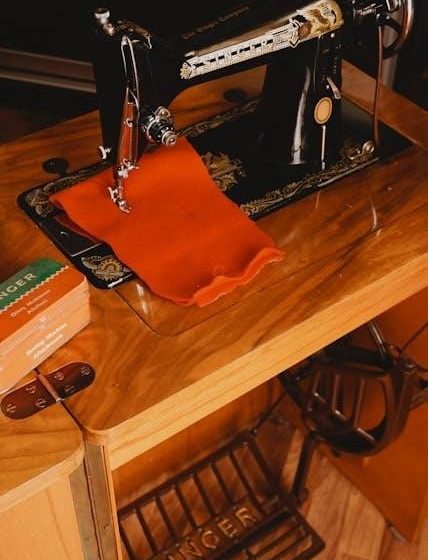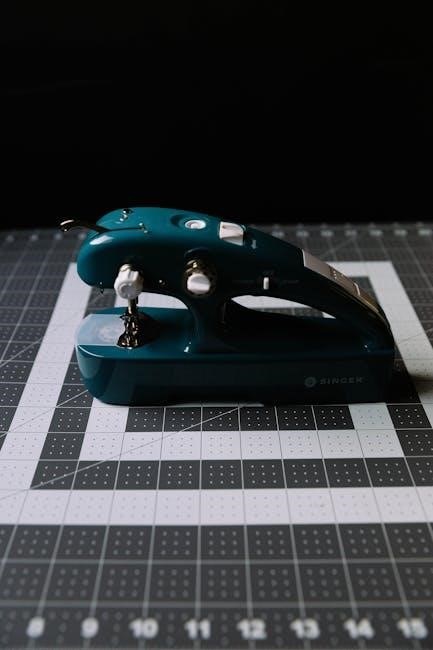singer 1120 manual

Welcome to the Singer 1120 Manual, your comprehensive guide to understanding and mastering this versatile sewing machine. Designed for both beginners and experienced sewists, this manual covers mechanical features, stitch options, and troubleshooting tips to ensure optimal performance. With clear instructions and practical advice, it helps you unlock the full potential of your Singer 1120, making sewing projects easier and more enjoyable.
1.1 Overview of the Singer 1120 Sewing Machine
The Singer 1120 is a mechanical sewing machine designed for versatility and ease of use, making it ideal for both beginners and experienced sewists. It offers a range of stitch options, automatic needle threading, and adjustable stitch length, catering to various fabric types. Known for its durability and user-friendly design, the Singer 1120 is a reliable choice for sewing projects, from simple repairs to complex creations, ensuring precise and professional results every time.
1.2 Importance of the Manual for Optimal Use
The Singer 1120 manual is essential for unlocking the machine’s full potential, ensuring proper setup, and troubleshooting common issues. It provides step-by-step guides for threading, bobbin installation, and stitch selection, helping users avoid mistakes and achieve professional results. Whether you’re a beginner or experienced sewist, the manual offers clear instructions to maximize efficiency and creativity, making it an indispensable resource for seamless sewing experiences with the Singer 1120.

Key Features of the Singer 1120 Sewing Machine
The Singer 1120 offers a durable mechanical design, versatile stitch options, and user-friendly controls, making it ideal for both beginners and experienced sewists. Its robust build and customizable features ensure precise stitching and effortless operation, catering to a wide range of sewing projects with ease and efficiency.
2.1 Mechanical Design and Build Quality
The Singer 1120 boasts a robust mechanical design with a durable metal frame, ensuring stability and longevity. Its compact build makes it easy to handle and maintain, while the high-quality components provide smooth operation. The machine’s mechanical nature allows for straightforward troubleshooting and repair, making it a reliable choice for sewists of all skill levels. Its rugged construction and timeless design ensure it remains a dependable tool for years of sewing projects.
2.2 Stitch Options and Customization
The Singer 1120 offers a variety of stitch options, including straight stitch, zigzag, and reverse stitching, catering to diverse sewing needs. Users can customize stitch length and width to suit different fabrics and projects. The machine’s mechanical design allows for easy adjustment of these settings, ensuring precise control over stitching. This versatility makes it ideal for both simple repairs and intricate sewing projects, providing a tailored experience for every sewist.
2.3 Ease of Use for Beginners
The Singer 1120 is designed with beginners in mind, featuring an intuitive interface and straightforward controls. The clear threading path and automatic needle threader simplify setup, reducing frustration. Step-by-step instructions in the manual guide users through basic operations, while the machine’s mechanical simplicity ensures smooth operation. This makes the Singer 1120 an excellent choice for those new to sewing, allowing them to focus on learning and creativity without getting overwhelmed by complex features.

Threading and Setting Up the Machine
Threading and setting up the Singer 1120 is straightforward with the manual’s step-by-step guide. Properly threading the machine and installing the bobbin ensures smooth stitching and optimal performance.
3.1 Step-by-Step Threading Guide
Threading the Singer 1120 begins by placing the spool on the pin and drawing the thread through the guide. Gently pull the thread down toward the tension discs, ensuring it’s seated properly. Next, bring the thread through the take-up lever and insert it into the needle’s eye from front to back. Keep the thread taut but not tight to maintain even tension. Proper threading is essential for smooth operation and consistent stitching.
3.2 Proper Bobbin Installation
Installing the bobbin correctly is crucial for smooth stitching. Start by removing any remaining thread from the old bobbin. Place the new bobbin into the bobbin case, ensuring it sits flush and aligns with the machine’s mechanism. Pull the thread through the bobbin case’s slot, leaving a small tail. Gently tug the thread to ensure the bobbin is properly seated. Avoid overfilling the bobbin, as this can cause tension issues. Always use the correct type of bobbin for your Singer 1120 to maintain optimal performance and prevent threading problems.

3.3 Adjusting Tension for Smooth Stitching
To ensure smooth stitching on your Singer 1120, proper thread tension is essential. Begin by threading the machine correctly, following the manual’s guidelines. Test your stitches on a scrap fabric. If stitches are uneven, adjust the top thread tension dial—clockwise for tighter thread and counterclockwise for looser. For bobbin tension, access the bobbin case and make small adjustments. Use appropriate thread type for your fabric, and check presser foot pressure to prevent uneven feeding. Regularly clean and maintain the machine to keep tension consistent. Patience and small adjustments will help achieve balanced stitches.

Maintenance and Cleaning
Regular cleaning prevents dust buildup, ensuring smooth operation. Lubricate moving parts periodically for optimal performance. Store the machine in a dry place to maintain longevity. Refer to the manual for specific guidance on maintenance routines.
4;1 Regular Cleaning to Prevent Dust Buildup
Regular cleaning is essential to maintain the Singer 1120’s performance. Dust and debris can accumulate inside the machine, causing mechanical issues. Use a soft brush to gently remove dust from the bobbin area, tension discs, and other visible parts. After sewing, wipe the exterior with a damp cloth to prevent grime buildup. Ensure all parts are dry before storing. Cleaning regularly ensures smooth stitching and prolongs the machine’s lifespan. Always unplug the machine before cleaning for safety.
4.2 Lubrication Tips for Smooth Operation
Regular lubrication is crucial for the Singer 1120’s smooth operation. Apply a few drops of sewing machine oil to moving metal parts, such as the bobbin area and needle bar. Avoid over-lubricating, as excess oil can attract dust. Use high-quality sewing machine oil for optimal performance. Lubricate every 50 hours of use or when you notice friction. Always unplug the machine before lubrication to ensure safety. Proper lubrication prevents wear and tear, ensuring consistent stitching and extending the machine’s lifespan.
4.3 Storage Recommendations
Proper storage is essential to maintain the Singer 1120’s condition. After cleaning, store the machine in a dry, cool place away from direct sunlight. Use a breathable cover or the original packaging to protect it from dust. Keep accessories in a separate, labeled container. Avoid storing the machine in humid or extreme temperature environments. Regularly inspect stored items for signs of damage or pests. Proper storage ensures the machine remains in excellent working condition for future use.

Troubleshooting Common Issues
Identify and resolve common Singer 1120 issues like thread breakage, uneven stitches, and bobbin problems. Check tension, threading, and needle alignment for smooth operation. Refer to the manual for detailed solutions to ensure optimal performance and extend the machine’s lifespan. Regular maintenance and proper setup are key to minimizing setbacks and achieving professional results in your sewing projects.
5.1 Identifying and Resolving Thread Breakage
Thread breakage on the Singer 1120 can occur due to improper threading, incorrect tension, or using the wrong needle type. Check the needle for damage or improper insertion. Ensure the machine is properly threaded, especially through the take-up lever and needle. Re-thread the machine with the presser foot up and pull gently to set tension. Use a needle threader for ease. If issues persist, consult the manual for guidance on adjusting settings or replacing the needle.
5.2 Fixing Uneven or Loose Stitches
Uneven or loose stitches on the Singer 1120 can result from incorrect tension settings, improper threading, or using the wrong needle type. Check the needle for damage or incorrect sizing. Ensure the machine is properly threaded, with the top thread passing through the take-up lever. Adjust the tension dials to balance the stitch formation. Using the correct needle for your fabric type and ensuring the presser foot is down while sewing can also resolve this issue. Consult the manual for specific tension adjustments.
5.3 Solving Bobbin-Related Problems
Bobbin-related issues, such as uneven winding or thread breakage, can disrupt your sewing. Ensure the bobbin is properly seated and aligned with the machine’s bobbin case. Check that the thread is wound evenly and not overloaded. If the bobbin thread is not pulling smoothly, verify that the bobbin case is correctly installed and the tension is balanced. Clean the bobbin area regularly to prevent dust buildup. Always use the recommended bobbin type for your Singer 1120 to avoid compatibility issues.

Accessories and Optional Attachments
Enhance your sewing experience with Singer 1120 accessories. Essential tools like presser feet and custom attachments allow for diverse fabric handling and specialized stitching techniques, expanding creativity.
6.1 Essential Accessories for Enhanced Sewing
Equipping your Singer 1120 with the right accessories elevates your sewing experience. Must-have items include a variety of presser feet, such as zigzag, zipper, and buttonhole feet, each designed for specific tasks. Additional bobbins ensure a steady thread supply, while specialized needles like sharp, universal, or heavy-duty options cater to different fabrics. A seam ripper, measuring tape, and sewing scissors are also indispensable for precision and convenience. These tools enhance versatility, making every project more efficient and enjoyable.
6.2 Using Presser Feet for Various Fabrics
The Singer 1120 supports a range of presser feet, each tailored for specific fabrics and tasks. The zigzag foot is ideal for general sewing, while the zipper foot excels with heavy or thick materials. A buttonhole foot simplifies creating custom buttons, and a walking foot is perfect for quilting or handling multiple layers. By selecting the right presser foot, you ensure better fabric control, reduce slippage, and achieve professional-grade results, making your sewing projects more precise and efficient.
6.3 Customizing with Additional Attachments
Expand your sewing capabilities with optional attachments designed for the Singer 1120. A ruffler attachment adds volume to fabrics, while a quilting guide enhances precision for large projects. Additional accessories like a seam guide or edge joiner help with specialized tasks, ensuring accuracy and versatility. These attachments allow you to explore advanced sewing techniques, making your Singer 1120 even more adaptable to your creative needs and improving the overall quality of your projects.

Tips for Getting the Most Out of Your Singer 1120
Maximize your Singer 1120’s performance by regularly cleaning, using the right needles, and exploring stitch options. Proper threading and tension adjustment ensure smooth sewing, while experimenting with fabrics and accessories expands your creative possibilities.
7.1 Choosing the Right Needles and Threads
Selecting the appropriate needles and threads is crucial for optimal sewing results with your Singer 1120. Use high-quality, fabric-specific threads to prevent breakage and ensure smooth stitching. Choose needles based on fabric type—sharp for woven fabrics and blunt for knits. Regularly inspect and replace dull or damaged needles to maintain consistent stitch quality. Always consult your manual for recommended needle sizes and thread types to achieve professional-grade sewing outcomes.
7.2 Mastering Different Fabric Types
Understanding fabric types is essential for achieving professional results with your Singer 1120. Start by identifying fabric categories such as woven, knit, and specialty fabrics like silk or denim. Adjust stitch length and tension based on fabric weight and texture. Use appropriate presser feet to handle delicate or thick materials effectively. Experiment with scraps to ensure settings are optimal before working on your final project. This adaptability ensures consistent stitching and prevents fabric damage, enhancing your sewing experience.
7.3 Time-Saving Techniques for Sewing Projects
Maximize efficiency with your Singer 1120 by implementing time-saving techniques. Pre-cut fabrics and organize threads before starting projects. Utilize the machine’s stitch customization to minimize manual adjustments. Use presser feet designed for specific fabrics to streamline sewing. Batch similar tasks, like hemming or seaming, to maintain workflow. Regularly maintain the machine to prevent delays. These strategies help you complete projects faster while maintaining quality, making sewing more enjoyable and productive.

Understanding the Machine’s Components
Familiarize yourself with the Singer 1120’s key components, such as the needle, bobbin, presser foot, and tension controls. Understanding these parts ensures proper operation and troubleshooting.
8.1 Principal Parts and Their Functions
The Singer 1120 features essential components like the needle, bobbin, presser foot, and tension controls. The needle creates stitches, while the bobbin holds the bottom thread. The presser foot keeps fabric stable, and tension controls adjust thread tightness. The stitch selector allows choosing stitch patterns, and the power switch controls machine operation. Understanding these parts is crucial for effective sewing and troubleshooting common issues. This section provides a detailed breakdown of each component’s role in the sewing process.
8.2 Diagrams for Visual Reference
The Singer 1120 manual includes detailed diagrams to visually guide users through machine setup and operation. These diagrams illustrate key components, such as the bobbin area, tension controls, and stitch selection. Clear visuals help users understand thread flow, presser foot attachment, and needle alignment. The diagrams complement written instructions, making it easier to identify parts and follow steps accurately. They are essential for troubleshooting and ensuring proper machine assembly and use, enhancing the overall sewing experience.
The Singer 1120 offers a versatile stitch selection system, providing various options for different fabrics and projects. With a range of straight, zigzag, and decorative stitches, users can customize their sewing tasks. The manual guides you through selecting the right stitch for your fabric type, adjusting stitch length and width, and troubleshooting common issues. This feature ensures precision and creativity, making it easy to achieve professional-looking results for both basic and complex sewing projects. Proper use of the stitch selection system enhances efficiency and versatility, catering to all skill levels. Safety is crucial when operating the Singer 1120. Always unplug the machine when not in use, keep loose clothing tied back, and avoid sewing when fatigued. Ensure children and pets stay away while sewing. Follow all guidelines in the manual to prevent accidents and ensure a safe, enjoyable sewing experience. Always unplug the Singer 1120 when not in use to prevent accidental start-ups. Keep loose clothing and long hair tied back to avoid entanglement. Ensure the work area is well-lit and clear of clutter. Avoid sewing when fatigued or distracted. Never leave the machine unattended near children or pets. Use only Singer-recommended accessories to maintain safety standards. Follow all instructions in the manual to ensure safe and efficient operation. Common sewing mistakes with the Singer 1120 often stem from improper threading or needle issues. Ensure the needle is correctly installed and threaded front to back. Use the right needle type and size for your fabric to prevent breakage. Avoid using the wrong bobbin size, as this can cause uneven stitching. Regularly check tension settings and refer to the manual for guidance. Keeping the machine clean and well-maintained will also help minimize errors and ensure smooth operation. In case of a malfunction, unplug the Singer 1120 immediately to prevent further damage. Check for thread tangles or obstructed pathways. Consult the manual for specific troubleshooting steps. If the machine jams, gently remove any fabric or debris without forcing parts. Ensure all screws are tightly secured and the presser foot is properly engaged. If issues persist, refer to the manual or contact Singer support for assistance. Regular maintenance can help prevent such emergencies. The Singer 1120 Manual is a comprehensive guide designed to help users of all skill levels master their sewing machine. It provides clear instructions, troubleshooting tips, and maintenance advice, ensuring optimal performance and longevity. With this manual, you’ll gain confidence in your sewing abilities and unlock endless creative possibilities. Happy sewing! The Singer 1120 Manual is an invaluable resource for mastering your sewing machine. It covers everything from setup and maintenance to troubleshooting common issues like thread breakage and bobbin problems. Whether you’re a beginner or an experienced sewist, this guide empowers you with the knowledge to optimize performance and tackle projects with confidence. By following its clear instructions, you’ll unlock the full potential of your Singer 1120 and enjoy a seamless sewing experience. As you master the Singer 1120, we encourage you to explore beyond the basics. Experiment with various fabrics, stitches, and techniques to expand your sewing skills. The machine’s versatility allows you to tackle diverse projects, from simple repairs to intricate designs. Don’t hesitate to try new patterns or accessories—each project is an opportunity to grow. Remember, sewing is a journey of creativity and learning. Keep experimenting, and enjoy the satisfaction of creating something truly unique with your Singer 1120.8.3 Exploring the Stitch Selection System

Safety Precautions
9.1 General Safety Guidelines
9.2 Avoiding Common Sewing Mistakes
9.3 Emergency Tips for Machine Malfunctions
10.1 Final Thoughts on the Singer 1120 Manual
10.2 Encouragement for Further Exploration